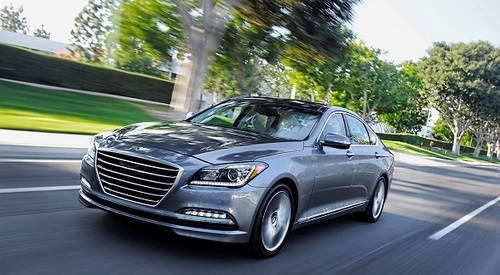2015 Genesis - Hyundai's Answer to German Luxury; Review By Thom Cannell +VIDEO
By Thom Cannell
Senior Editor
Michigan Bureau
The Auto Channel
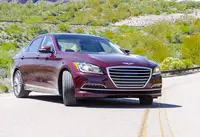 2015 Hyundai Genesis |
Hyundai’s 2015 Genesis, new from chassis to sunroof, was designed to satisfy younger customers, youth defined by attitude not chronology. They are discerning buyers accustomed to discovering the best solution regardless of tradition, though heritage and status do factor in. They’re the ones searching Kickstarter, Thrilllist and other innovation engines broadcasting innovative goods and services. They will appreciate this car for its excellence, its luxury and soul.
With charming modesty Hyundai declares its 2015 Genesis a competitor for Mercedes E Class and BMW 5 Series. Have they succeeded in delivering luxury and competence at that level of excellence? We, and other experienced writers, agree the answer is a resounding yes. Let’s tick off a few hallmark boxes, those that symbolize the provenience of luxury European automobile brands: extensive Nürburgring Nordschleife testing? Certainly. Powerful engines in two flavors? Absolutely. All Wheel Drive availability? Yes, for the V-6, no for the V-8. Economy-oriented I-4 engines? No, no, no.
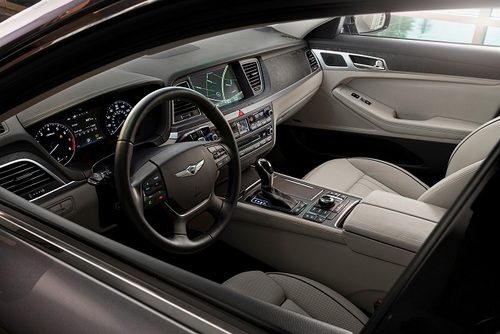 |
Beyond established basics, does Genesis have amazing electronic assistance to support your travels, rich tactile leather stitched like Prada’s best, quietness that rivals a carpeted cathedral, and an exterior worthy of a second, third, and lingering glance? All of those without qualification. But are they sufficient? For that answer we drove rear wheel drive versions of the V-6 Genesis and a similar V-8.
Like the brands they challenge, Genesis engines define models precisely. The Lambda 3.8-liter V-6 delivers sufficient power for the desires of most buyers, plus a 5.0-liter Tau V-8 awaits those who simply demand the best an automaker can deliver. The payoff to ordering the V-6 is that it alone is available with all-wheel-drive. Our colleagues uniformly report that the all-wheel-drive system, supplied by Magna International, is the most planted of all Genesis. You ask why no AWD for the V-8? Hyundai is uncertain they could equip even 200 cars a year, making it far too costly an option.
Watch the introduction of the 2015 Hyundai Genesis at the 2014 Detroit Auto Show
Distinction runs even deeper in the driving dynamics, only the eight cylinder engine delivers a nasty little growl at wide open throttle, one we suspect Hyundai surreptitiously permitted into the cabin to satisfy performance enthusiasts. The V-6 with all-wheel-drive is a respectable performer with over 300 horsepower and the HTRAC all-wheel-drive system delivers either neutral and rear wheel drive oriented performance depending on the driver’s control settings. Both cars allow Normal, Sport, and ECO modes which change engine performance and steering compliance in either, plus delivering continuously variable damping to the 420 horsepower V-8.
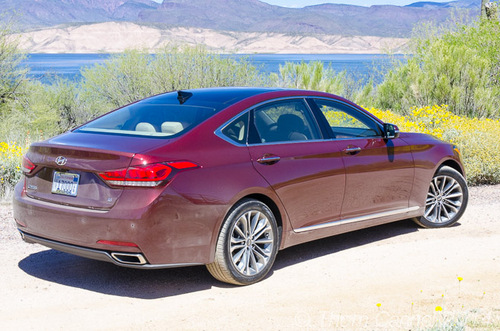 |
Impossible to see but readily felt and hugely important is Hyundais increasing emphasis on the use of high strength and ultrahigh strength steel which is, according to their metrics, the largest percentage of the body in their comparison group. High and ultrahigh strength steel delivers crash worthiness, uncompromising driving dynamics, quietness and even things you can see and appreciate, like a slender A pillar. Due to rollover and roof crush standards, many A pillars block oncoming traffic, even vehicles as large as a semi. Not so here. HSS improves rigidity in sensations like bending between the front wheels and the back wheels, or twisting as in going over potholes holes and undulating pavement. HSS also assists in meeting crash standards where all the force has to be transmitted through load paths that do not have an impact on passengers. Assembly is more spacecraft than automobile with panels first bonded with over 400 feet of structural adhesives, then laser welded. That also creates structural bone and muscle that you can sense.
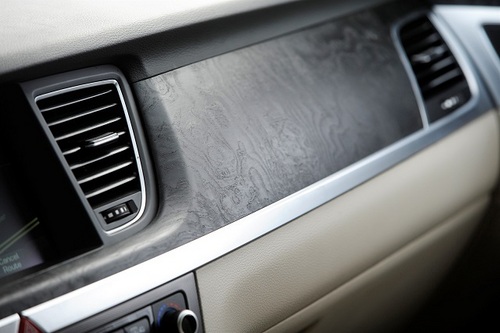 |
Inside the cabin you might also think that Hyundai owns a share of the forest Jaguar and Audi use, as well as similar leather suppliers. In the cars we drove, open grain low gloss woods charmed us with their organic simplicity. They spoke eloquently in creating openness in Genesis’ passenger cabin; it is the opposite of cramped cockpit designs. They do use, in a few selected areas, a process where patterns are floated on water and transferred to plastic pieces with a degree of similarity that is astonishing. Where they are, we do not know. We did not find them. Our awareness was of an expanse of wood that swept from door-to-door around the vehicle with restrained elegance, not just luxury. Genesis aura is of comfort, roominess, and calm.
There are, of course, exclusive features in the new car. One is a CO2 monitor to warn and insure fresh air in the cabin if CO2 levels rise to the “you’ll get drowsy” level. Another is Smart Trunk which acknowledges your loitering presence near the trunk by opening magically, no buttons or soccer kicks required. Several advanced technologies are notable, a combination of radar-based cruise control and camera-base lane keeping can merge to assist your driving. That’s partially enabled by variable on-rack steering. Moving the power system onto the steering rack (which has fine teeth in the center for sharp on-center steering and less teeth at the ends for faster turning) is a key enabler. Lastly, Lotus Engineering was engaged to validate Genesis’ driving dynamics. There were suggestions for improvement, but overall what Hyundai created was minimally altered by Lotus. According to them Genesis has a fine set of vehicle dynamics, in some cases surpassing the benchmarks with ease.
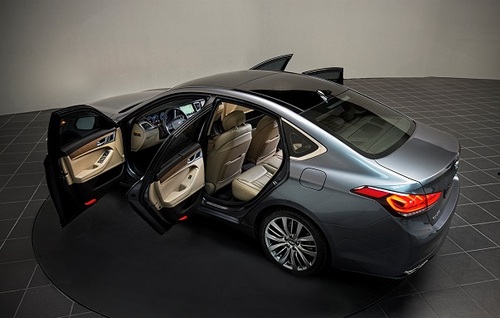 |
We also tried the infotainment technology included in both of our cars. The standard BlueLink telematics system (service scheduling, vehicle health, stolen car, emergency notification, remote start with climate control, remote unlock, etc.) just works. Their choice in audiophile sound is a Lexicon Discrete Logic 7 900 Watt 12 or 17 speaker surround sound system which, set at neutral, delivered clarity and depth. After we (briefly) altered those settings we could shake the car off its tires.
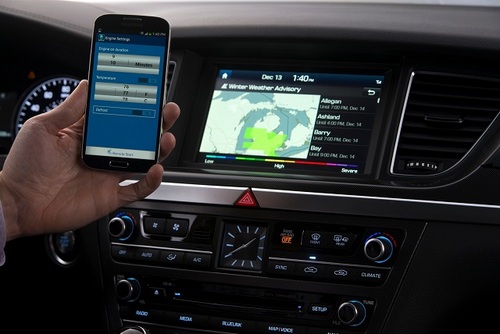 |
Both cars were also equipped with the segment’s first 9.2” HD 720p display. It includes apps like maps, Gracenote album art, adds HD radio and satellite audio, POI searches, 30GB of storage, and all features of the standard system like aha radio, Pandora audio, and split-screen navigation. All were there to use—if we’d had an extra day to learn their features. Best for us was we could use Apple's Siri for our iPhones by simply holding down the button that activates the listen feature of the telematics system longer than normal. Oh my, that opened sports scores, weather, gasoline prices, other searches, plus sending texts or email by voice command as you usually do with Siri.
If you travel frequently you’ll want the premium system. When in navigation mode it displays both a split screen for upcoming turns as well as an overall map, as do others. Where it excelled was showing both the upcoming turn and the next turn as well. A surprisingly useful feature we’ve not seen before.
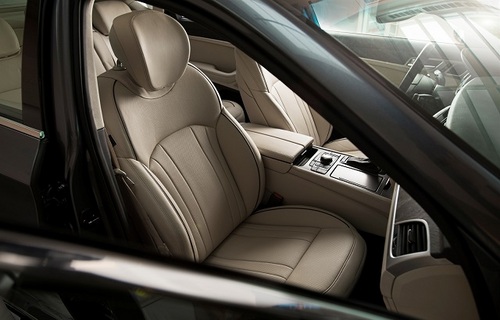 |
The final question is how does it compare to the champions Hyundai says it bests? Impressively well. If you’ve investigated German Sport Sedans they have a characteristic firmness that many find harsh, particularly on poorly maintained roads. Genesis specifically does not claim to be a sports sedan, though it displays all of the handling and ride control of the best sports sedans. It is one notch less stern without losing its edge. An apt comparison might be titanium versus steel, titanium feeling lighter, more agile, less stolid. Genesis is titanium. This is best felt in its steering which has the best on-center feel available.
Interiors, which we touched on, are as sumptuous as any in the class of contenders—models from Lexus, Cadillac, Mercedes, Audi, BMW—with an openness and sophistication that makes long distance motoring serene. Controls over systems are logically placed and, thanks to on-the-wheel controls, you can change almost any setting as you drive.
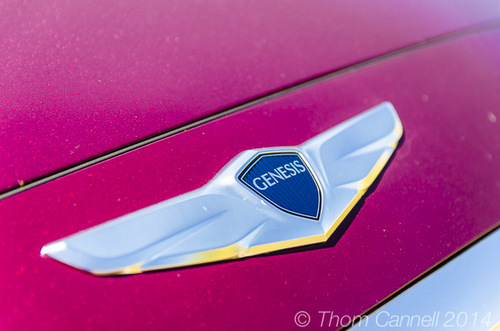 |
Lastly, does Genesis deliver the classic and enduring exterior beauty the class demands? We think so. Brashness has been subtly tamed by artfully easing the curves of signature Fluidic Sculpture. The character line now flows from front headlight to full LED backlight with a tall roof that politely glides over all passengers as it delivers plenty of front and rear headroom. A new hexagonal grille emphasizes power without turning into a caricature grin. In sum it looks the part of a luxury vehicle. One thing the Genesis has retained is cost advantage over its rivals. This can be as modest as $7,000 or grand as $13,900 (as defined by Hyundai figures) without giving up even one luxury feature, perhaps delivering more.
Hyundai says Genesis is not just a value, it is valuable.
We agree.



